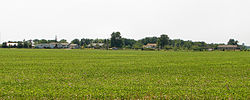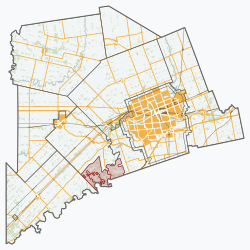Communities
The township contains the communities of Adelaide, Crathie, Dejong, Kerwood, Keyser, Mullifarry, Napier, Napperton, Springfield, Walkers and Wrightmans Corners. The administrative offices of the township are in the locality of Adelaide.
Demographics
In the 2021 Census of Population conducted by Statistics Canada, Adelaide-Metcalfe had a population of 3,011 living in 1,013 of its 1,056 total private dwellings, a change of 0.7% from its 2016 population of 2,990. With a land area of 331.11 km2 (127.84 sq mi), it had a population density of 9.1/km2 (23.6/sq mi) in 2021. [6]
According to the 2011 Canadian Census, the median age was 39.7 years old which is approximately the same as the national average at 40.6 years old. [7]
According to the 2011 National Household Survey, 85.8% of Adelaide Metcalfe residents are Canadian citizens by birth, and about 2.5% of residents are recent immigrants (from 2001 to 2011). Residents of Adelaide Metcalfe are primarily White (96.6%), with a small community of Koreans (3.3%). Specifically, residents of Adelaide Metcalfe identify their ethnic origin as: Canadian (36.2%), English (32.1%), Dutch (27.2%), Scottish (26%), and Irish (18.2%). According to the 2011 Census, English is the mother tongue of 87.2% of the population, with a small population of Dutch (4.7%) and Portuguese (2.3%) speakers. [8] [7] Adelaide Metcalfe has 63.7% Christian adherents whereas 35.7% does not affiliate with any religion. [8]
The highest levels of education obtained by residents aged 25 to 64 years old, are as follows: 43.1% of people have a post-secondary schooling degree (including 9.2% with a University degree or higher), 32.6% have a high school degree (or equivalent) and 24.2% have no certificate, diploma or degree; these represent somewhat higher education rates than Canadian averages at 64.1%, 23.2%, & 12.7% respectively. [8]
The median household income before taxes is $28,644, and after taxes is $26,846; lower than the provincial or national figures at $66,358 and $61,072 pre-tax ($58,717 and $54,089 after tax) respectively. The median commute time to work for those 15 years and over was 20.3 minutes with almost all commutes (94.3%) done by personal vehicle as a driver. The median value of a dwelling in Adelaide Metcalfe is $250,399 which is less than the Canadian median value of $280,552 and the Ontario median value of $300,862. [8]
This page is based on this
Wikipedia article Text is available under the
CC BY-SA 4.0 license; additional terms may apply.
Images, videos and audio are available under their respective licenses.



